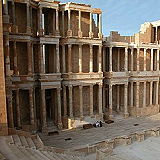Libya » Lby
Place »

|
Sabratha Ancient Theatre Libya » LBY Place » Historical Place Sabratah, Libya 46 views 💖 1 |
|
The Ancient Theatre of Sabratha is one of the most striking and well-preserved remnants of Roman architecture in North Africa. Located in the ancient city of Sabratha, Libya, which was part of the Roman province of Tripolitania, the theatre dates back to the 2nd century CE, during the reign of Emperor Septimius Severus, who himself was born in nearby Leptis Magna. | |

|
Sabratha Museum Libya » LBY Place » Museum Sabratah, Libya 52 views 💖 1 |
|
The Sabratha Museum is located in the ancient city of Sabratha, Libya, which was part of the Roman Empire and a significant city in the region. Sabratha itself is a UNESCO World Heritage Site, famed for its well-preserved Roman ruins, including a majestic theater, temples, and basilicas. | |

|
Ancient Sabratha Libya » LBY Place » Historical Place Sabratah, Libya 64 views 💖 1 |
|
Ancient Sabratha, located in present-day Sabratah, Libya, was one of the major cities of the Roman province of Tripolitania. Founded in the 5th century BCE by the Phoenicians, Sabratha became an important center for trade, particularly for the exchange of goods between the Mediterranean and the African interior. Its strategic location on the coast made it a crucial part of the Phoenician network of trading cities along the North African coast. | |

|
Great Sand Sea Libya » LBY Place » Outdoors Libya 227 views 💖 1 |
|
The Grand Erg Oriental (English: 'Great Eastern Sand Sea') is a large erg or "field of sand dunes" in the Sahara Desert. Situated for the most part in Saharan lowlands of northeast Algeria, the Grand Erg Oriental covers an area some 600 km wide by 200 km north to south. The erg's northeastern edge spills over into neighbouring Tunisia. | |

|
Libya Libya » LBY Place » City Libya 60 views 💖 1 |
|
Libya is a country located in North Africa. Libya features diverse landscapes, including the vast Sahara Desert, the Mediterranean coastline, and a range of mountainous areas. The country’s terrain is mostly barren with occasional oases. Islam, specifically Sunni Islam, is the dominant religion. Islamic traditions and cultural practices play a significant role in daily life. Its population was 7,361,263 in 2024. | |